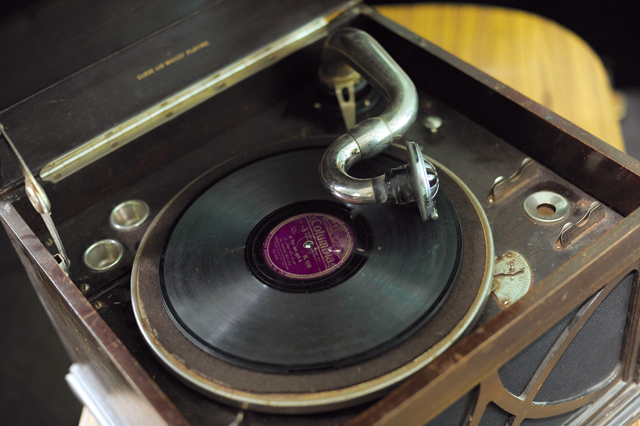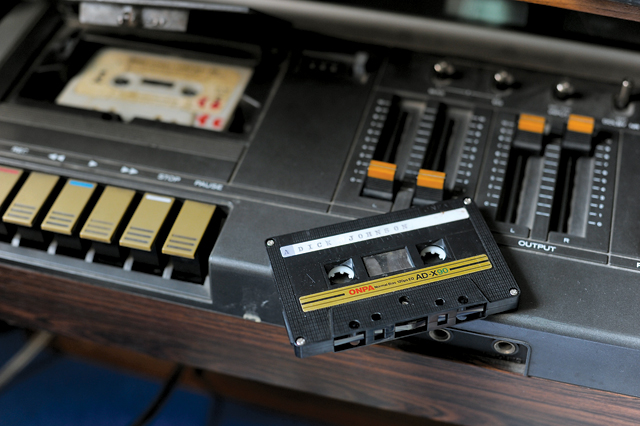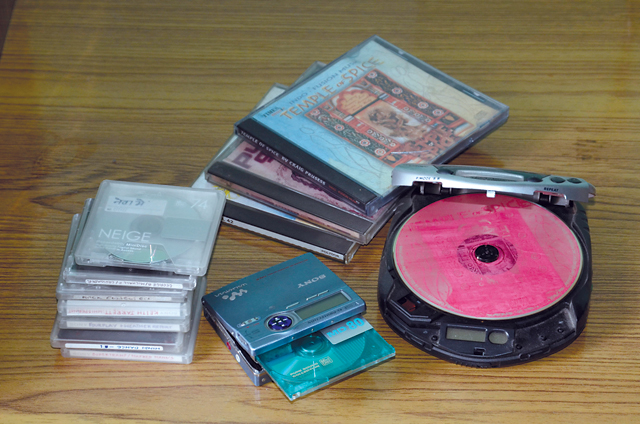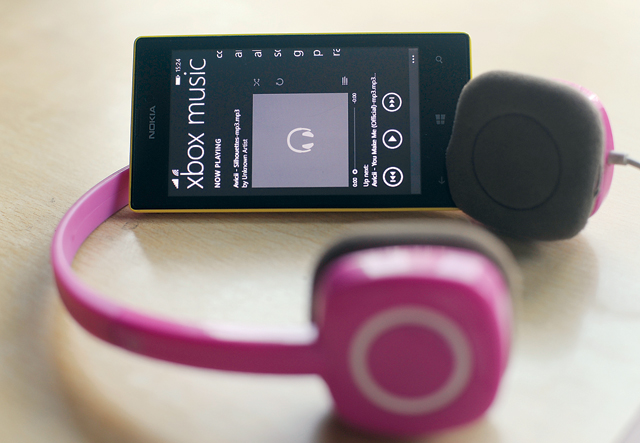The introduction of the gramophone by aristocrats in the early 20th century can be seen as the genesis of Nepal’s music industry. With vinyl records being replaced by audiocassettes, compact discs, and digital data, the music business in the local market has taken giant leaps over the years.

Upendra Lal Singh is a pianist and a music teacher. He has also produced several internationally acclaimed albums with his band, Upendra and Friends. During one of my visits to his house, I noticed an antique wind up gramophone, which immediately piqued my interest. I wanted to know more about it, so I talked to Singh’s father about its history. Its past, as it turns out, was regal. According to him, the record player had been presented to his grandfather-in-law by a senior member of the royal family as a gesture of appreciation for being that particular individual’s music teacher. He also added that the device is about to reach its seventh decade since the date of its handover.
The gramophone is the oldest in Singh’s collection. On a previous visit, he had shown me three other record players, each representing different eras. This was notable due to the differences in the technology involved (i.e. classic speed controller, electronic, and DJ). In addition, he has a rare collection of around fifty vinyl records ranging from the early 60s to the late 80s.
During that visit, I also had the opportunity to listen to those same records on the electric gramophone. Singh even made me compare its sound with cassettes, compact discs, and digital data music players respectively. “Did you notice the powerful bass output in the older players?” he later asked.
The wind-up gramophone at Singh’s house is an emblem of history. It harkens back to a time when vinyl discs were first introduced to Nepal, a few decades after its invention. The impact of the record player still echoes today albeit via different mediums, but to what extent and results was what I wanted to find out.
Back in the day...
In my quest to learn about the transitions in Nepal’s music production and listening culture, I land up at Nirmal Hoda’s office in Chabahill. Hoda is the founder of Santana Records, an 18-year-old record label that has been responsible for putting out a number of albums by popular Nepali musicians such as Arun Thapa, Om Bikram Bista, Nabin K. Bhattarai, Nima Rumba, Mukti & Revival, and 1974 AD to name a few. The record label also ran a recording studio from 1995 to 2005. When it was established, it was amongst the very few studios in Kathmandu. Considering his experience, it was apparent that Hoda, who was also the drummer of Yogeshwor Amatya’s Rock Yogis, would be able to answer my queries.
We start off by talking about the genesis of recorded music in Nepal - the vinyl. “Only four songs could be pressed into a record. They were very expensive and were manufactured either in Singapore or in Calcutta,” he explains about the vinyl-making process, adding that only a few aristocratic families were able to afford gramophones.
The history of recorded Nepali music dates back to 1908 when Setu Ram Shrestha, who sang in Newari, established himself as one of the first recording artists in the country. He was soon joined by Mitra Sen Thapa and Melwadevi Manadhar. “What followed was a stream of albums by Tara Devi, Narayan Gopal, Aruna Lama, and Gyanu Lama,” says Hoda, who also tells me that the first company to officially produce vinyl records was the now-defunct Ratna Recording Sansthan, a government owned body.

The era of audiocassettes
Almost two decades ago, audiocassettes, along with Sony’s legendary portable cassette player, Walkman (and its many imitators), were prerequisites for music listeners in Nepal. Today, with local record companies having ceased production of cassette tapes, they have become mere symbols of nostalgia.
According to Hoda, audiocassettes started replacing records almost three decades ago when Music Nepal became the first private record company to put out cassettes. With the introduction of tapes, the music scenario of Nepal changed rapidly. “People could afford to buy albums easily and cassette players too were cheaper than record players,” reminisces Hoda. From what he knows, the first albums to be released on audiotapes were the MaHa jodi’s Yamalok and some of Gyanendra Lama’s recordings.
“Unfortunately, tapes also gave birth to piracy,” adds Hoda. Saying this, he reveals that laws regarding the control of piracy were still as vague then as it is now. Even so, it was easy to physically distinguish what was original and what was not.
“The problem with audiocassettes was that they didn’t last very long,” recalls Hoda. “Since they had to be discarded, in some cases, people had to buy the same album multiples times.”
After audiocassettes came the cleaner and clearer sounding compact disc (CD).

A disc that still survives
One of the first Nepali bands to release albums on CD was Sur Sudha. With CDs taking over the market in the early to mid-90s, musicians were able to propound their ideas visually along with their compositions, thanks to the larger flaps.
However, despite the CD takeover in urban centers, the market in rural areas was still dominated by audiocassettes even until the early to mid-2000s. “But for the past five years, mp3s have taken over completely. This is the case in remote areas as well,” says Nirmal Hoda. “Even CD players have slots for pen drives these days!”
Despite this, a lot of Nepali musicians still prefer to release their albums on CDs, although many contain links to websites where their music can be downloaded.

The digital age
The new way of selling music i.e. through digital media stores comes with bigger options, even for the Nepali music industry. While the iTunes Store is the biggest of the lot, the case in Nepal is a bit different.
“Although people abroad do buy Nepali music on iTunes, those in Nepal itself are unable to do so, chiefly because purchasing music on iTunes requires a credit card, which a majority of people here don’t own,” says Hoda.
That, however, is not the case with Music Nepal, the only local record label with an authorized iTunes account. The oldest record label in the country also sells music through alternative payment means including Paybill, PayWay, eSewa, PayPal, and via associate banks that host SCT debit cards, through its website (www.musicnepal.com).
Another popular form of revenue for local musicians and record labels for the past few years has been Caller Ring Back Tones (CRBT). “This service is rapidly growing,” remarks Hoda. “At one time, Nepal Telecom even had to stall its CRBT service in order to install more digital drivers.” Other providers of CRBTs include telecommunication companies such as Ncell, UTL, and Smartcell. Local television channels, radio stations, newspapers, and online portals all feature advertisements about the service.
If you are keen on listening to new Nepali tunes over the Internet legally, websites like muncha.com and geetinepal.com sell and stream numerous registered songs.
“Our website acts like a virtual wallet where you can create your cash deposits. With the help of ipay.com.np, users can connect their accounts from our associate banks,” says Sarseej P. Pradhan, Media Manager of muncha.com. The banks in question include Nepal Investment Bank, Kumari Bank, Everest Bank, Laxmi Bank, and Bank of Asia. An audio preview of the songs can be streamed, after which the customers can choose to buy them for Rs.25 each.
“We give details to the record companies and the artists on a quarterly basis, along with the payments,” adds Pradhan, who also reveals that most of their customers live outside Nepal. The website has signed up with well known musicians such as Mukti & Revival, Adrian Pradhan, Nepathya, Kutumba, Cobweb, and Sanjay Shrestha so far.
Technology versus classics
Within a century of music production, our local music scene has gone from records to digital players. As technology has advanced each year, the selling of legal audio has also taken new forms locally.
These days, it is common to see digital data players that play compressed low quality audio data such as mp3s. In fact, this trend has pushed aside the concept of physically visible music records. Listening to records or even audiocassettes have become as obsolete as the broken needle of Singh’s wind-up gramophone.
In the case of Nepal, there seems to be very few people willing to get their hands on original and physical records, CDs, or tapes, although a few of us do opt to purchase song files via legal websites.
Some months ago, I tuned into the BBC Nepal radio service where I was lucky enough to hear a few lines of an audio documentary about music production. Although I cannot recall the journalists name, I’ll never forget what he had to say at the end of his show: “Although digital audio has surpassed the sales of CDs at the moment, the feel of looking at the album cover, touching it, and reading the lyrics is something that might be symbolically compared with the phrase ‘touching the soul.’”
Has your soul been touched lately?











